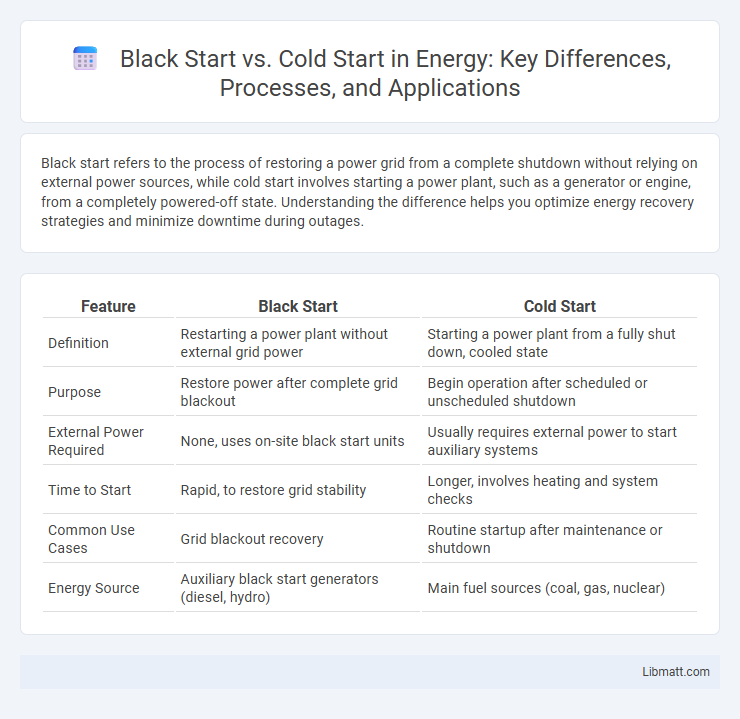Black start refers to the process of restoring a power grid from a complete shutdown without relying on external power sources, while cold start involves starting a power plant, such as a generator or engine, from a completely powered-off state. Understanding the difference helps you optimize energy recovery strategies and minimize downtime during outages.
Table of Comparison
| Feature | Black Start | Cold Start |
|---|---|---|
| Definition | Restarting a power plant without external grid power | Starting a power plant from a fully shut down, cooled state |
| Purpose | Restore power after complete grid blackout | Begin operation after scheduled or unscheduled shutdown |
| External Power Required | None, uses on-site black start units | Usually requires external power to start auxiliary systems |
| Time to Start | Rapid, to restore grid stability | Longer, involves heating and system checks |
| Common Use Cases | Grid blackout recovery | Routine startup after maintenance or shutdown |
| Energy Source | Auxiliary black start generators (diesel, hydro) | Main fuel sources (coal, gas, nuclear) |
Understanding Black Start: Definition and Importance
Black Start is the process of restoring a power station to operation without relying on the external electric power transmission network. It is crucial for recovering from a complete or partial blackout, ensuring grid reliability and stability. Power plants equipped with Black Start capabilities use onsite generators or auxiliary power to initiate operation, enabling the sequential restoration of other grid components.
Demystifying Cold Start: What It Means in Power Systems
Cold start in power systems refers to the process of energizing a power plant or grid section without any external power supply, requiring essential equipment to be started from zero energy levels. Unlike black start, which involves restoring power after a complete shutdown using specialized units, cold start emphasizes the initial activation procedure under completely de-energized conditions. Understanding cold start protocols is crucial for grid stability and ensures reliable power restoration after extensive outages or system maintenance.
Key Differences Between Black Start and Cold Start
Black Start refers to restoring a power grid from a complete shutdown without external power, relying on on-site generation units to energize the system, while Cold Start involves starting up a power plant or equipment from a completely de-energized and cooled state without prior running conditions. The key difference lies in Black Start's focus on grid restoration during a blackout, whereas Cold Start emphasizes initiating individual machinery or plants under ambient conditions. Black Start procedures require specialized black start units and coordination across the grid, contrasting with Cold Start's equipment-specific startup protocols.
The Role of Black Start in Grid Recovery
Black Start plays a critical role in grid recovery by enabling power plants to restart independently without relying on the external electric power grid. This capability is essential during large-scale blackouts when the entire grid is down, allowing the restoration process to begin systematically. Your understanding of Black Start procedures can enhance resilience and ensure a quicker return to normal grid operations compared to a Cold Start, which requires external power to initiate startup.
Cold Start Procedures in Power Plants
Cold start procedures in power plants involve initiating power generation from a completely de-energized state, requiring external power sources or black start generators to revive the system. These steps include sequentially energizing auxiliary systems, synchronizing generators, and gradually restoring load to prevent system instability. Effective cold start protocols are critical for ensuring rapid recovery after total grid shutdowns and minimizing blackout durations.
Technical Requirements: Black Start vs Cold Start
Black Start requires specialized equipment such as onboard generators and black start capacitors to restart a power grid without external power sources, whereas a Cold Start typically needs external power supply to energize the system before starting. Technical requirements for Black Start include coordinating auxiliary power plants capable of operating in isolation and stringent control system protocols to prevent grid instability. Understanding these distinctions helps you prepare appropriate infrastructure and operational strategies for reliable power restoration.
Challenges Faced During Black Start Operations
Black start operations face significant challenges, including the need to restart power plants without any external power supply, which demands precise coordination and reliable black start resources like diesel generators or hydro plants. You must manage synchronization of multiple grid sections while ensuring system stability and preventing voltage collapse. Maintaining communication and rapidly restoring critical infrastructure while coping with potential equipment malfunctions complicates the process.
Cold Start Risks and Mitigation Strategies
Cold start risks primarily involve prolonged system downtime and potential data loss due to the complete shutdown of equipment and absence of power. Mitigation strategies include implementing robust backup power solutions, maintaining detailed system documentation for rapid restoration, and conducting regular drills to ensure swift recovery processes. Your preparedness in cold start scenarios ensures minimized operational disruptions and enhanced system reliability.
Real-world Examples: Black Start and Cold Start Events
The 2003 Northeast blackout in the United States and Canada demonstrated a critical black start event, where power plants had to restart without external power after a massive grid failure. In contrast, cold start scenarios frequently occur in data centers, such as during planned maintenance or unexpected outages, requiring servers and systems to boot up from a completely powered-down state. These real-world examples highlight the importance of black start capabilities for grid resilience and cold start procedures for IT infrastructure recovery.
Future Trends in Power System Restoration
Future trends in power system restoration emphasize the integration of advanced Black Start capabilities using renewable energy sources and energy storage systems to enhance grid resilience and reduce restoration time. Emerging technologies like microgrids and smart grids enable more flexible and localized Cold Start procedures, minimizing system blackouts. Your power infrastructure will increasingly rely on automated controls and real-time data analytics to optimize restoration strategies and ensure rapid recovery after outages.
Black Start vs Cold Start Infographic

 libmatt.com
libmatt.com